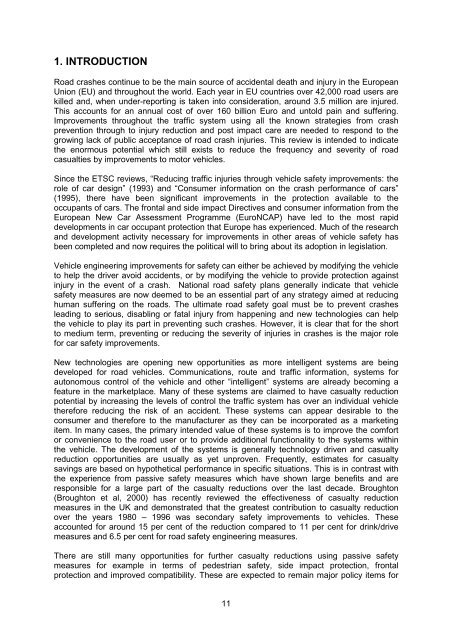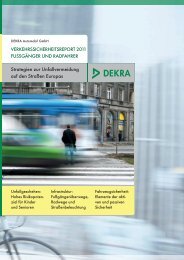PRIORITIES FOR EU MOTOR VEHICLE SAFETY DESIGN
priorities for eu motor vehicle safety design - ETSC
priorities for eu motor vehicle safety design - ETSC
You also want an ePaper? Increase the reach of your titles
YUMPU automatically turns print PDFs into web optimized ePapers that Google loves.
1. INTRODUCTION<br />
Road crashes continue to be the main source of accidental death and injury in the European<br />
Union (<strong>EU</strong>) and throughout the world. Each year in <strong>EU</strong> countries over 42,000 road users are<br />
killed and, when under-reporting is taken into consideration, around 3.5 million are injured.<br />
This accounts for an annual cost of over 160 billion Euro and untold pain and suffering.<br />
Improvements throughout the traffic system using all the known strategies from crash<br />
prevention through to injury reduction and post impact care are needed to respond to the<br />
growing lack of public acceptance of road crash injuries. This review is intended to indicate<br />
the enormous potential which still exists to reduce the frequency and severity of road<br />
casualties by improvements to motor vehicles.<br />
Since the ETSC reviews, “Reducing traffic injuries through vehicle safety improvements: the<br />
role of car design” (1993) and “Consumer information on the crash performance of cars”<br />
(1995), there have been significant improvements in the protection available to the<br />
occupants of cars. The frontal and side impact Directives and consumer information from the<br />
European New Car Assessment Programme (EuroNCAP) have led to the most rapid<br />
developments in car occupant protection that Europe has experienced. Much of the research<br />
and development activity necessary for improvements in other areas of vehicle safety has<br />
been completed and now requires the political will to bring about its adoption in legislation.<br />
Vehicle engineering improvements for safety can either be achieved by modifying the vehicle<br />
to help the driver avoid accidents, or by modifying the vehicle to provide protection against<br />
injury in the event of a crash. National road safety plans generally indicate that vehicle<br />
safety measures are now deemed to be an essential part of any strategy aimed at reducing<br />
human suffering on the roads. The ultimate road safety goal must be to prevent crashes<br />
leading to serious, disabling or fatal injury from happening and new technologies can help<br />
the vehicle to play its part in preventing such crashes. However, it is clear that for the short<br />
to medium term, preventing or reducing the severity of injuries in crashes is the major role<br />
for car safety improvements.<br />
New technologies are opening new opportunities as more intelligent systems are being<br />
developed for road vehicles. Communications, route and traffic information, systems for<br />
autonomous control of the vehicle and other “intelligent” systems are already becoming a<br />
feature in the marketplace. Many of these systems are claimed to have casualty reduction<br />
potential by increasing the levels of control the traffic system has over an individual vehicle<br />
therefore reducing the risk of an accident. These systems can appear desirable to the<br />
consumer and therefore to the manufacturer as they can be incorporated as a marketing<br />
item. In many cases, the primary intended value of these systems is to improve the comfort<br />
or convenience to the road user or to provide additional functionality to the systems within<br />
the vehicle. The development of the systems is generally technology driven and casualty<br />
reduction opportunities are usually as yet unproven. Frequently, estimates for casualty<br />
savings are based on hypothetical performance in specific situations. This is in contrast with<br />
the experience from passive safety measures which have shown large benefits and are<br />
responsible for a large part of the casualty reductions over the last decade. Broughton<br />
(Broughton et al, 2000) has recently reviewed the effectiveness of casualty reduction<br />
measures in the UK and demonstrated that the greatest contribution to casualty reduction<br />
over the years 1980 – 1996 was secondary safety improvements to vehicles. These<br />
accounted for around 15 per cent of the reduction compared to 11 per cent for drink/drive<br />
measures and 6.5 per cent for road safety engineering measures.<br />
There are still many opportunities for further casualty reductions using passive safety<br />
measures for example in terms of pedestrian safety, side impact protection, frontal<br />
protection and improved compatibility. These are expected to remain major policy items for<br />
11



